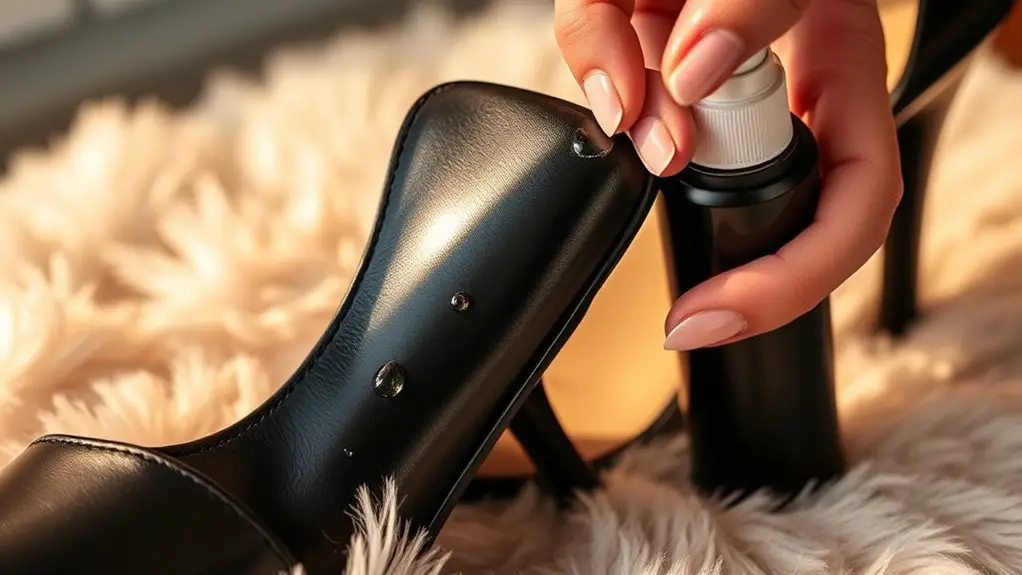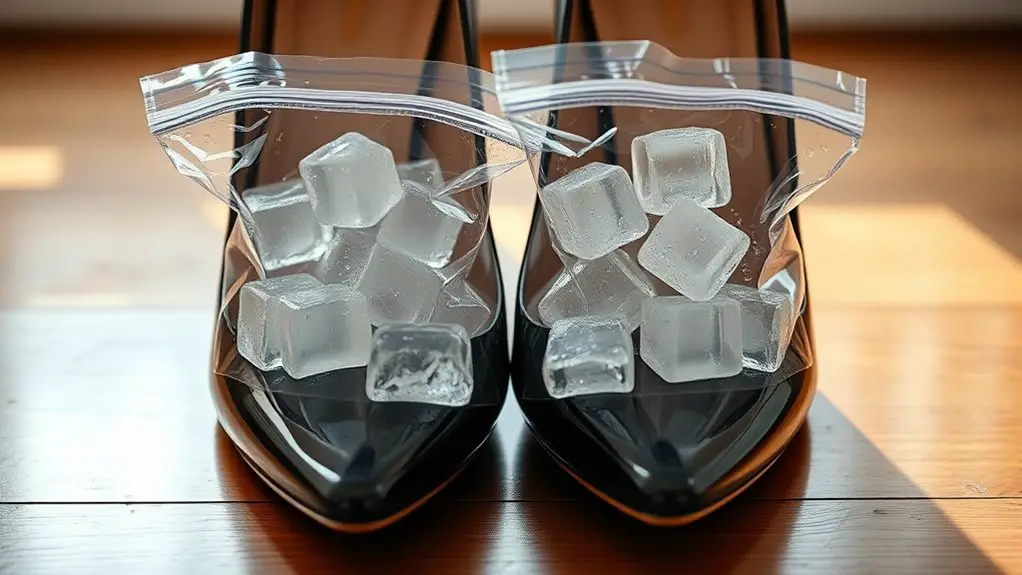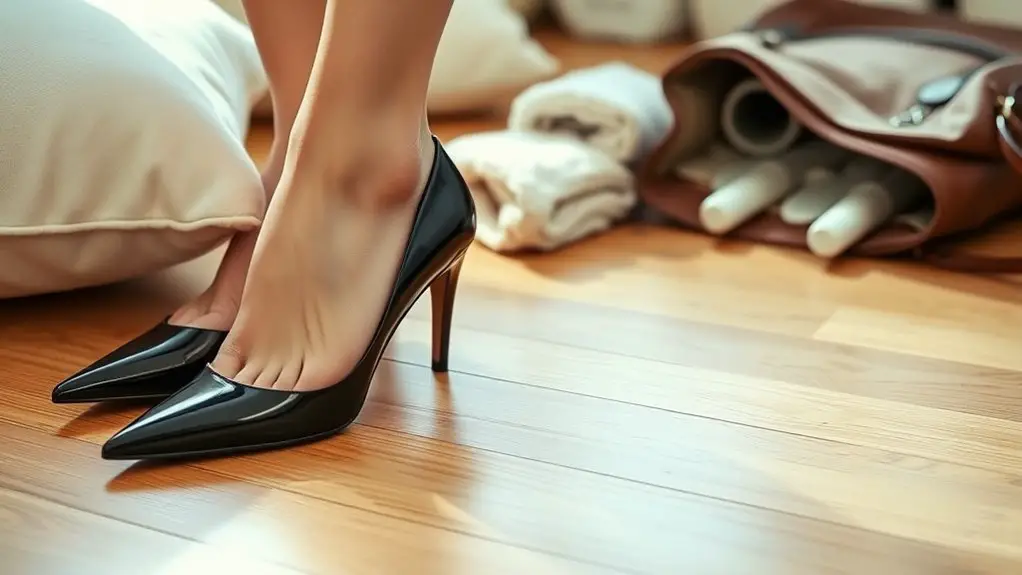To instantly break in heels without pain, start by wearing thick socks to stretch the material gradually. Use a hairdryer to soften the shoes while they’re on your feet, flexing them as you go. Consider applying a leather conditioner or stretch spray for added flexibility. Walk on different surfaces to build stability, and use gel inserts for extra comfort. You can also freeze water in a bag placed inside the shoes for additional stretching. There’s more to boosting your comfort!
Choose the Right Size and Style

When you’re searching for the perfect pair of heels, it’s vital to choose the right size and style to guarantee comfort from the start. A proper heel fit is significant; your heels should feel snug but not tight. Make certain there’s enough room for your toes to move freely without pinching. It’s also wise to take into account the heel height; lower heels can provide more stability, especially if you’re not used to wearing them.
Additionally, think about style versatility. Opt for classic designs that can shift from day to night, allowing you to wear them on various occasions. Look for heels with adjustable straps or cushioned insoles, as these features can enhance comfort. Remember, the right combination of size and style not only elevates your outfit but also guarantees that you can wear your heels confidently without the dreaded pain. Prioritizing these factors will set you up for a more enjoyable wearing experience.
Wear Thick Socks for Stretching
Wearing thick socks is a simple yet effective way to stretch your heels gradually. Choose socks that fit snugly without being too tight, as this will help create the right amount of pressure. Remember to increase your wear time slowly to avoid overstretching and damaging your shoes.
Choose the Right Socks
Finding the right socks can make a significant difference in breaking in your heels comfortably. Opt for thick socks made from breathable sock materials like cotton or wool. The added sock thickness helps stretch the shoes without causing discomfort. When you wear these socks, they create a barrier between your feet and the stiff material of your heels, reducing friction and preventing blisters. Look for socks that offer a snug fit but aren’t overly tight; this will allow your shoes to stretch gradually while keeping your feet cushioned. Remember, the goal is to guarantee your heels mold to your feet, so don’t underestimate the power of the right socks in your breaking-in process.
Gradual Wear Time
Once you’ve chosen the right socks, it’s time to ease your heels into your routine gradually. This method utilizes thick socks to stretch your shoes, enhancing heel comfort over time. Start by wearing your heels for short periods, increasing the duration as they begin to mold to your feet. Here’s a simple breakdown of how to implement this breaking technique:
| Day | Sock Thickness | Wear Time | Comfort Level |
|---|---|---|---|
| Day 1 | Thick | 30 minutes | Moderate |
| Day 2 | Thick | 1 hour | Good |
| Day 3 | Medium | 1.5 hours | Comfortable |
| Day 4 | Medium | 2 hours | Very Comfortable |
Avoid Overstretching Heels
While thick socks can help stretch your heels, it’s vital to avoid overstretching them, which can lead to discomfort and a poor fit. Start by wearing your heels for short periods while using thick socks to gently expand the heel material. Monitor how the shoes feel; if they start to feel too loose, it’s a sign you’ve gone too far. Proper shoe maintenance is important—clean the material regularly and store them appropriately to maintain their shape. If you notice your heels not fitting right after stretching, consider using inserts for added support. This approach guarantees you enjoy stylish heels without sacrificing comfort, helping you navigate your day with confidence.
Use a Hairdryer to Soften Material
One effective method to break in heels and enhance comfort is by using a hairdryer to soften the material. This hairdryer technique can greatly improve the flexibility of your shoes, making them more comfortable to wear. Here’s how to do it effectively:
A hairdryer can soften your heels, making them more flexible and comfortable to wear.
- Prepare Your Heels: Put on thick socks and wear your heels to stretch them slightly before applying heat.
- Heat the Material: Use the hairdryer on a low setting, focusing on the areas that feel tight. Keep it about 6 inches away to avoid damage.
- Flex As You Heat: While applying heat, gently flex and wiggle your feet in the shoes to encourage material flexibility.
- Cool Down: Once the material feels softer, let the shoes cool while still on your feet. This helps them mold to your shape.
Apply Leather Conditioner or Stretch Spray

After softening the material with a hairdryer, another effective approach to breaking in heels is to apply leather conditioner or stretch spray. These products not only enhance leather care but also facilitate stretching techniques that help mold your heels to your feet.
| Product Type | Benefits | Application Tips |
|---|---|---|
| Leather Conditioner | Softens and nourishes leather | Apply evenly, focusing on seams |
| Stretch Spray | Aids in stretching without damage | Spray inside and outside of the shoe |
| Combination of Both | Maximizes comfort and flexibility | Use together for best results |
To use, simply spray or apply the conditioner directly onto the areas that feel tight. Allow it to sit for a few minutes before wearing your heels. This method not only reduces discomfort but also prolongs the life of your favorite shoes.
Walk on Different Surfaces
To break in your heels effectively, you’ll want to walk on a variety of surfaces. Start on soft surfaces like carpets to ease into the shoes, then gradually challenge yourself on harder ground to build confidence. Don’t forget to practice on uneven terrain, as it helps you become more aware of how your heels respond to different conditions.
Soft Surfaces Practice
Walking on soft surfaces is an effective way to ease into wearing heels without discomfort. By practicing on these forgiving terrains, you can build confidence and strengthen your balance. Here are some soft surface exercises you can try:
- Carpet Practice: Walk on a plush carpet to minimize impact and allow for easier gliding.
- Grass Strolls: Navigate a grassy area to engage your stabilizing muscles, helping you adapt to the heels.
- Yoga Mats: Use a cushioned mat indoors for controlled, low-stress practice.
- Sand Walking: If you’re near a beach, walking on sand can help improve your foot strength and flexibility.
These exercises will help you enjoy your heels while keeping discomfort at bay!
Hard Surfaces Challenge
While you may feel hesitant to shift to harder surfaces, mastering this challenge is essential for building your heel-wearing confidence. Start by practicing on tiles, concrete, or hardwood floors to get accustomed to the surface impact. Use hard surface techniques like taking smaller, deliberate steps to maintain balance and reduce strain. Focus on your posture—keep your shoulders back and your head up. This will help distribute your weight more evenly and lessen discomfort. Gradually increase your practice time on these surfaces, allowing your feet to adapt. Remember, the more you expose your heels to hard surfaces, the easier it’ll become. Before you know it, you’ll be strutting confidently, ready to conquer any environment!
Uneven Terrain Awareness
Once you’re comfortable on hard surfaces, it’s time to tackle the challenge of uneven terrain. Maneuvering uneven surfaces can be intimidating, but with practice, you can master this skill. Here are some tips to enhance your terrain maneuvering:
- Start on Grass: It cushions your steps and helps you gauge balance.
- Try Cobblestones: These will test your heel grip and stability.
- Walk on Sand: This offers a unique challenge, forcing you to adapt your gait.
- Explore Trails: Uneven paths will strengthen your confidence and skills.
Use Gel Inserts for Extra Comfort
One effective way to enhance comfort when breaking in heels is by using gel inserts. These inserts come in various gel types, including full-length insoles, ball-of-foot pads, and heel grips. Each type serves a specific purpose, so you can choose based on your needs. For instance, ball-of-foot pads provide extra cushioning where you need it most, reducing pressure and preventing discomfort.
The comfort benefits of gel inserts are significant. They absorb shock, distribute weight evenly, and reduce friction, making your heels more bearable for longer periods. By adding these inserts, you’ll not only ease the breaking-in process but also improve your overall experience in heels.
Make sure to select high-quality gel inserts that fit snugly in your shoes. With the right gel type, you’ll find that your heels become much more manageable, allowing you to walk confidently and comfortably.
Freeze Water in a Bag Inside the Shoes

If you’re looking for a creative way to stretch your heels without the discomfort, freezing water in a bag and placing it inside the shoes is a practical solution. This method leverages water expansion, which can effectively loosen various shoe materials. Here’s how to do it:
- Use a sturdy freezer bag: Verify it’s leak-proof, preventing any water from escaping.
- Fill it with water: Leave some space for expansion as it freezes.
- Place the bag inside your shoes: Position it strategically to target tight areas.
- Freeze overnight: The water will expand as it freezes, gently stretching the shoe material.
Once you remove the bags, let your shoes thaw for a few minutes. This simple technique not only helps in breaking in your heels but also keeps the process pain-free, making your footwear more comfortable for those long days ahead.
Gradually Increase Wearing Time
As you commence breaking in your new heels, gradually increasing your wearing time is essential for minimizing discomfort and allowing your feet to adjust. Start with just 15 to 30 minutes of incremental wear around your home. This short duration helps your feet begin acclimating to the heel height and style without overwhelming them.
After a few days, assess your comfort level. If you feel good, extend your wearing time by 15 to 20 minutes. Monitor any signs of discomfort, as they can indicate when to pause or slow down the process.
Incorporate these comfort assessments regularly. Pay attention to any pressure points or blisters developing, and adjust your wearing schedule accordingly. Over time, you’ll build your stamina and confidence in those heels, making them a more enjoyable addition to your wardrobe. Remember, patience is key to achieving the perfect fit without pain.
Frequently Asked Questions
Can I Break in Heels Overnight?
You can’t fully break in heels overnight, but you can try quick solutions for overnight comfort. Use thick socks and a hairdryer, or freeze water-filled bags in your shoes to gently stretch them while you sleep.
How Long Does It Take to Break in Heels?
On average, it takes about 3-4 wears to break in heels effectively. For ideal heel comfort, consider using break in tips like wearing thick socks or using a shoe stretcher to ease the process.
What Should I Do if My Heels Still Hurt?
If your heels still hurt, try using gel inserts for pain relief. Additionally, adjust your walking style and take breaks. Consider wearing them for shorter periods initially, gradually increasing wear to enhance comfort.
Are All Heel Types Difficult to Break In?
Not all heel types are created equal. Platform heels and wedge heels often offer more comfort, while stiletto comfort can be elusive. Block heel support provides stability, making them easier to break in than you might think.
Can I Use These Methods on Synthetic Heels?
Yes, you can use these methods on synthetic heels. Just remember, synthetic materials often lack natural flexibility. Adapt your techniques to enhance heel flexibility, ensuring a more comfortable fit while breaking them in effectively.



